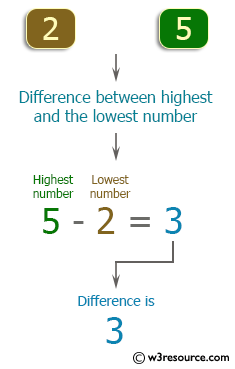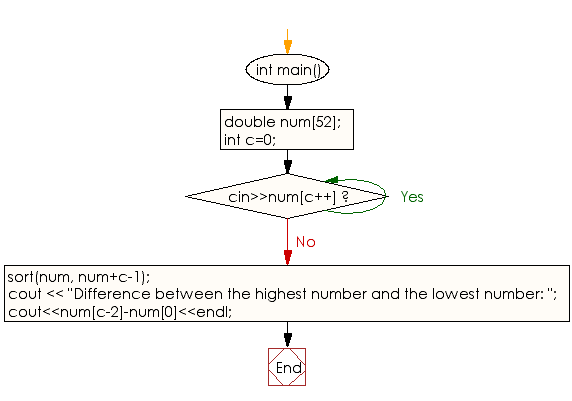C++ Exercises: Compute the difference between the highest number and the lowest number
Difference Between Max and Min Numbers
Write a C++ program that accepts various numbers and computes the difference between the highest number and the lowest number. All input numbers should be real numbers between 0 and 1,000,000. The output (real numbers) may include an error of 0.01 or less.
Visual Presentation:

Sample Solution:
C++ Code :
#include <iostream> // Header file for input/output stream operations
using namespace std;
int main()
{
double num[52]; // Array to store up to 52 double numbers
int c = 0; // Counter variable initialized to 0
// Loop to read numbers from input and store them in the 'num' array
while (cin >> num[c++]); // Reads numbers until invalid input is encountered and increments the counter 'c'
sort(num, num + c - 1); // Sorting the array of numbers
// Displaying the difference between the highest and lowest numbers entered
cout << "Difference between the highest number and the lowest number: ";
cout << num[c - 2] - num[0] << endl; // Output the difference between the highest and lowest numbers
return 0; // Indicating successful completion of the program
}
Sample Output:
Sample Input: 2 5 Difference between the highest number and the lowest number: 3
Flowchart:

For more Practice: Solve these Related Problems:
- Write a C++ program to read a list of real numbers and then compute the difference between the highest and lowest values using loops.
- Write a C++ program that accepts floating-point numbers, determines the maximum and minimum, and then calculates their difference with error tolerance.
- Write a C++ program to compute the difference between the maximum and minimum values in an array without using built-in functions.
- Write a C++ program that finds the max and min numbers in a dynamically allocated array and then prints the difference with two decimal precision.
Go to:
PREV : Sales Total and Average Quantity.
NEXT : Sum of First n Primes.
C++ Code Editor:
Have another way to solve this solution? Contribute your code (and comments) through Disqus.
What is the difficulty level of this exercise?
